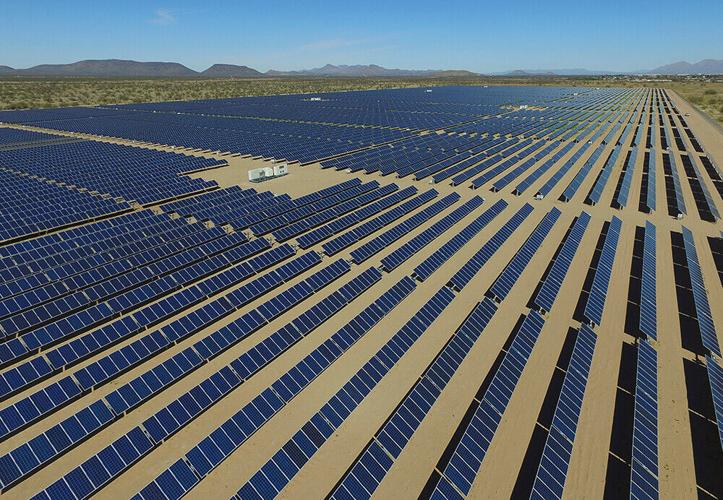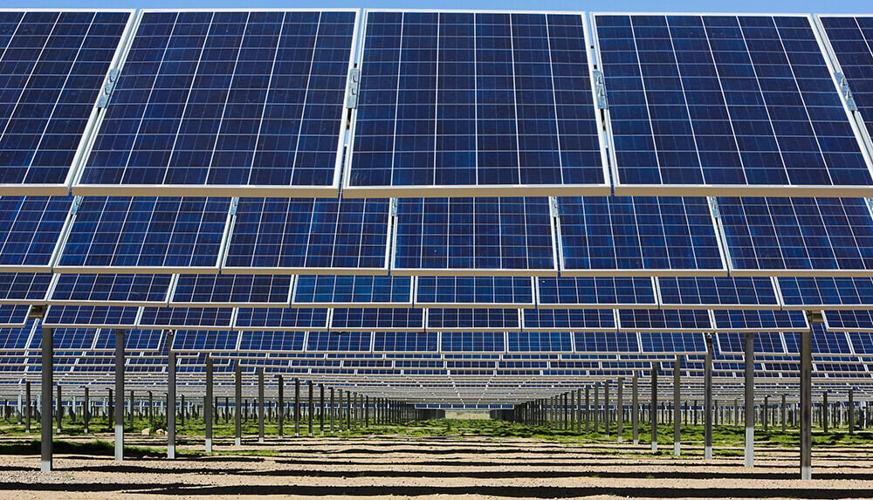By late next year, Tucson Electric Power customers could start getting power from two large solar farms in Cochise County planned under a federal law requiring utilities to buy low-cost power from qualifying renewable-energy plants.
TEP has asked state regulators for approval of agreements to buy power from the planned Babacomari North and Babacomari South photovoltaic projects — which at a capacity of 80 megawatts each would be the second-largest solar farms serving Tucson.
The projects were proposed by Idaho-based developer Clēnera on the Babacomari Ranch, southwest of the junction of State Routes 90 and 82 and northwest of Huachuca City.
Clēnera applied to TEP to supply power from the solar farms under the federal Public Utility Regulatory Policies Act of 1978, or PURPA.
The law requires a utility to buy power from certain smaller renewable-energy projects called qualifying facilities when their prices are less than the utility’s “avoided cost” — what it would otherwise pay to generate or buy power from other sources.
TEP filed applications with the Arizona Corporation Commission for approval of each of the Babacomari solar projects in June — the first time it has sought such approval.
The company asked the commission to act on its requests at its next open meeting in mid-September, or not act it on and allow it to become considered approved after that date under an alternative in the law.
TEP says with timely regulatory approval, it expects the North phase of the project to begin supplying solar power by the end of 2022, and the South phase to go online by mid-2023.
Long-term contract
In its application, TEP says that under its agreement with an affiliate of Clēnera, the Babacomari projects are “qualifying facilities” under PUPRA and the utility will get the full output of the solar plants for 18 years — now the minimum term for such contracts under landmark rules adopted by the Corporation Commission in 2019.
TEP said the Babacomari contracts include terms reasonably similar to other power-purchase agreements TEP has entered into, but the rates TEP will pay under the agreement were not disclosed in its public filing, which was redacted under confidentiality rules.
TEP and Arizona Public Service Co., the largest state-regulated utility, had opposed the 18-year length requirement for PURPA contracts, arguing that that the utility and its ratepayers could get locked into overpriced contracts as costs drop in the future.
The PURPA projects will help TEP toward its clean-energy goals of 70% renewable energy and an 80% cut in carbon emissions by 2035, but the company is less than thrilled it’s being forced into a long-term contract to buy the power from the Babacomari projects.
TEP Joe Barrios spokesman Joe Barrios said the Clēnera contract conditions are “acceptable” under PURPA but sounded a note of caution.
“However, being required to purchase power from unplanned projects can present engineering and resource planning challenges,” Barrios said. “While the avoided cost calculation is intended to treat both customers and developers fairly, the unique location and performance characteristics of these systems, combined with our inability to curtail their output, can lead to higher system integration costs that our customers ultimately pay.”
While the price TEP will pay for Babacomari solar power remains undisclosed, TEP was required to file an electric-rate rider for power purchases from smaller PURPA-qualified facilities with generating capacity of 100 kilowatt capacity or less.
Those rates range seasonally from about 2.1 cents to 2.5 cents per kilowatt-hour, though no one has yet signed up for the rate, Barrios said.
(That is for power generation only; the average monthly rate of about 12 cents per kWh that TEP home customers pay includes transmission, distribution and other costs.)
Barrios said that range for the 100kW systems is representative of the ceiling for the avoided cost rate calculated for the first large PURPA qualifying facility project.
TEP made news for in 2017, when it signed a contract to get power from a 100-megawatt solar project south of Tucson for less than 3 cents per kWh, plus 1.5 cents per kWh for storage — then an industry low.
That project, the Wilmot Energy Center, has been cranking out clean power since May as TEP’s biggest solar resource.
Avoided cost of power
Barrios noted that the avoided cost rate calculated for subsequent large PURPA projects will continue to decline.
That’s because the most costly energy is displaced first, so subsequent projects will displace energy sources that are less costly, resulting in a lower avoided cost, he explained.
A spokesman for Clēnera, which was recently acquired by Israel-based Enlight Renewable Energy, also declined to discuss details of the proposed TEP power purchase agreement but said the company is bullish on Arizona solar.
Clēnera built what is now TEP’s second-largest photovoltaic resource, the 35Mw Avalon I & II solar project in Sahuarita, which went online in phases in 2014 and 2016.
The company also plans two 80Mw projects in Coconino County to serve Arizona Public Service Co.
“We see Arizona as a market we would like to be active in, and we already have an existing operating project with TEP and have a good relationship with them,” said Jared McKee, vice president of business development for Clēnera. “We really believe Arizona will continue to be a market where we will want to invest our time and resources in projects that utilities will find attractive.”
The Cochise County Planning and Zoning Commission issued a special use authorizations for the Babacomari projects in December.
The Babocamari photovoltaic projects will occupy separate 540- and 560-acre plots on a larger 10,870-acre parcel, with the possibility of adding an energy storage system, county planning documents show.
A new mile-long utility line will be constructed between the two facilities and will tie into the existing TEP transmission line that runs from Fort Huachuca to the Tucson area.
Wave of projects
The Babacomari projects are just the beginning of a wave of merchant solar plants planned or proposed under Arizona’s PURPA rules.
TEP has issued draft power-purchase agreements for three other 80Mw solar projects: the Winchester I and II projects proposed by Torch Clean Energy for a site near Willcox; and the Serrano project, proposed by Longroad Energy for a site near Marana.
Eight other PURPA qualifying facility projects were proposed to TEP but have since been withdrawn, the utility says.
Meanwhile, Arizona Public Service won approval from the Corporation Commission in April for two 80Mw solar PURPA-qualifying facilities to be built by Clēnera on the CO Bar Ranch, about 30 miles northwest of Flagstaff.
APS is in negotiations for four other, 80Mw solar projects proposed as PURPA qualifying facilities but is not free to talk about those projects publicly, APS spokeswoman Yessica del Rincón said.
“While we make progress toward our clean energy commitment, we will continue to follow state and federal regulations as we process applications for those entities developing qualifying facilities,” she said, noting that project developers can also participate in the utility’s competitive market solicitations for renewable energy, which are done through a request-for-proposal bidding process.
APS, which can count power from its Palo Verde Nuclear Generating Station as carbon-free energy, has a goal of providing 65% carbon-free and 45% renewable energy by 2030, with a goal of 100% carbon-free by 2050.





